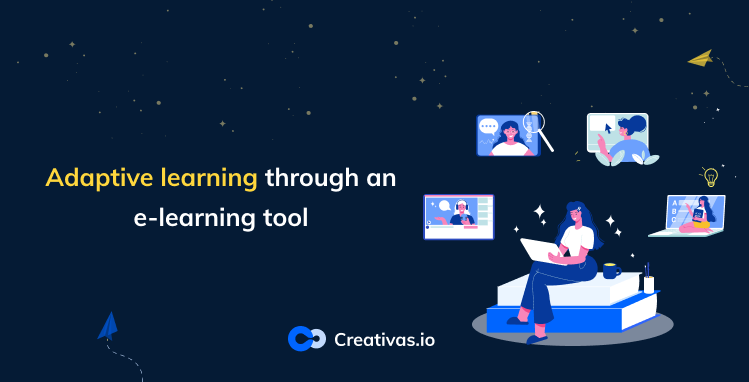
Adaptive learning through an e-learning tool
Adaptive learning has existed in education history since the 1950s, but people started paying it more attention again in 2020 when COVID invaded the world. With the existence of e-learning, people thought it’s a beneficial idea to merge adaptive learning with an e-learning tool, and more specifically, with a learning management system, LMS.
For those who don’t know adaptive learning, it’s “a type of personalized learning made possible by the use of computers. The adaptive learning system delivers assessments that evaluate students’ prior knowledge and then using artificial intelligence prescribes individualized learning content in a sequential manner that is designed to meet the learning needs of each individual.” (J. Ryoo and K. Winkelmann, 2021)
In other words, if we link this to e-learning, it’s about collecting personalized data about the learners, whether you’re an educational organization or a business, and then giving them custom online courses. The personalized data can be their personal learning needs, learning style, expectations, and so on.
There are 3 types of adaptive learning:
- Adaptivity of the content based on the learner’s needs
- Adaptivity of the content’s presentation mode and educational form
- Complete adaptivity (a mix between the two above)
How can we implement adaptive learning in an e-learning tool?
Different learning styles should be taken into consideration to ensure a reliable implementation. As you know in the pedagogy of teaching, the psychological and cognitive feature of the learner is vital because it has an impact on the learning style.
In this context, Felder and Silverman developed a 4 dimension-learning-styles model and called it the “Felder-Silverman Learning Styles Model (FSLSM)”. It guarantees adaptivity in e-learning tools and provides detailed information about each style to highlight the importance of each individual on aside. Each learner has their preferences and needs.
1. Active/Reflective
Active learners process information best when they are in teams or doing a classroom or team activity. They’re good team players. Reflective learners prefer individual work. They like to take their time to think about the information given.
2. Sensing/Intuitive
This is related to the type of information. Sensory learners are facts people. In other words, they like to go through real-life scenarios and practice real situations. They learn by living the moment as it is or by feeling like this happened in the real world. Intuitive learners are drawn to theories and hypothetical scenarios. Abstract ideas help them process the information better.
3. Visual/Verbal
This dimension is about the sensory channel, in which the learner prefers learning through visual or verbal information. The Felder-Silverman model states that most learners are visual ones. Visual learners engage better with graphs, illustrations, images, presentations, or diagrams, while verbal learners are more drawn to words, more specifically, texts or audio. They can also benefit from team discussions.
4. Sequential/Global
The 4th and the last dimension presents the progress of learning, whether it’s sequential or global. Starting with the sequential learners, they follow small but wise steps that most of the time have to be logical. They don’t do random steps. All information has to be organized systematically. Global learners, on the other hand, are the complete opposite. They tend to understand the entire image of the lesson but don’t know how they did it or what’s the connection between every piece of information. Give them a complex problem, and it will be solved, but they won’t tell you how they did it because they just don’t know how to explain it step by step.
Implementation of Adaptive learning into Smart Courses for Confluence LMS:
If you’re a Confluence user, you surely know Smart Courses or at least heard of it. It’s a learning management system that holds a massive list of features and offers the opportunity to insert many type of content. In the case of adaptive learning, we need personalized courses for learners, either in groups or individuals. In both cases, this is feasible with Smart Courses. All 4 dimensions of the Felder-Silverman learning styles model can be implemented in the courses with the variety of content types available on the app. You can even assign exams to them through the exam mode feature. More details about the app are here.



